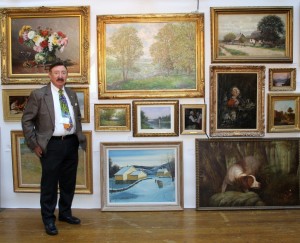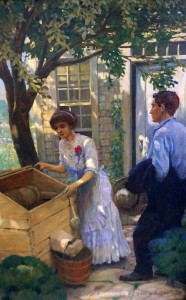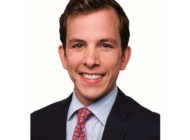
Bill Union with selections from his inventory of Nineteenth and early Twentieth Century American and European paintings.
“I’m old-fashioned. I stick to what I know and own almost all of my inventory of about 300 paintings,” says Massachusetts dealer Bill Union, who founded the Art & Antique Gallery in 1970 after developing a passion for Nineteenth and early Twentieth Century American and European pictures. Primarily a show dealer, Union stays busy shuttling between fairs in New England and Florida. He appears next in upstate New York over Columbus Day weekend at Barn Star Production’s Fall Antiques at Rhinebeck.
How did you get started?
My mother pushed me to study at the 92nd Street Y in New York City. Moses Soyer was my teacher. By the 1960s, I was working for the government and dealing in art and antiques on the side. I exhibited at Brimfield for the first time in 1964 and still do Brimfield three times a year. I’m a dealer’s dealer. I get all, or most, of my action on the first day.
What came next for you?
I started showing at the Northeast Trade Center in Woburn, Mass., for Bernice Bornstein. It was a major New England show in those days. I did the New Haven Coliseum shows for Milton and Bob Cottler. I was in a back room, with my pictures spread out on tables. I’d sell paintings like they were going out of style. Nothing over $500. For a while I had galleries in Worcester, Mass., and on Newbury Street in Boston, but shows were more productive. At one time, I did 48 shows a year, from New England to Texas. Lately, D’Amore Promotions’ Big Flea & Antiques Market in Fredericksburg, Va., has been very good. In general, though, show managers need to drop their prices. The booth rents are killing dealers.
How did your paintings business evolve?
I worked with the Boston dealers Willie Postar and Robert and Terry Vose, among others, and hung around with Bill Young, who wrote A Dictionary of American Arts, Sculptors and Engravers (1968). I’d go to Rockport, Mass., and fill up a van with 30 pictures. I developed a reputation for Emile A. Gruppe, Anthony Thieme and others who worked on the North Shore. Gruppe died in 1978 and had not yet been rediscovered. I paid $200 to $400 for Gruppes that now bring $6,000 to $8,000 or more. I handled portions of the estates of the artists Charles Hawthorne, Theodore E. Butler, William McGregor Paxton and Walter Griffin, and published a catalog in conjunction with a show I did on the Rhode Island artist Frederick Rhodes Sisson.
Where do you buy?
I’ve traveled the world, and bought and sold paintings all over Europe. I’d run a half-page advertisement with ten pictures or so. People started calling me the ‘Little Pictures Guy’. I was vacationing in Italy when a man said, ‘It’s the Little Pictures Guy!’ Now pickers bring me things. The only auction house I frequent is CRN in Cambridge, Mass. Carl Nordblom gets fresh stuff and doesn’t post prices on AskArt.com. I don’t like prices being exposed.
What is your approach to selling?
I don’t mark up my pictures. I give good prices, treat people fairly and guarantee what I sell. I sold a painting for $2,400 by the Boston painter Philip Little to a client in Florida. I saw a similar painting at the Palm Beach show marked $32,000. My best market is between $1,000 and $10,000.
Has the market changed?
It’s a different world. For one thing, all these kids born in the 1960s are into abstract art. Also, it’s the high end that’s selling. Most of my customers are collectors. Many of the New York dealers have faded out. For me, finding material isn’t a problem. All you need is money and a little smarts. I know everyone and find things other people don’t.
Best find and biggest regret?
I bought a Maurice Prendergast for $10 that went to a museum for $135,000. It was covered with dust and looked like a print. Sure enough, when I opened it up, it was an Italian-view watercolor. Alternately, I sold a Frederic Church, a Grandma Moses and a Hans Hoffmann. If I had them today, I wouldn’t be working.
Other interests?
I buy and sell antique cars. I have a ‘56 Olds, an ‘88 Porsche Carrera convertible and a 1940s Chevy. That’s still a good market. I hold out for my prices. I’d rather drive cars than sell them.
What’s on tap for Rhinebeck?
It’s a very good show that attracts a sophisticated crowd for Nineteenth Century New York landscapes, which I’ll have, along with works by Thomas Hill, Charles Hawthorne, Antonio Jacobsen, Henry Jarvis Peck and Charles Alston, among others. Alston is an African American painter, another category I’m interested in.
[slideshow_deploy id=’1000274945′]—Laura Beach





